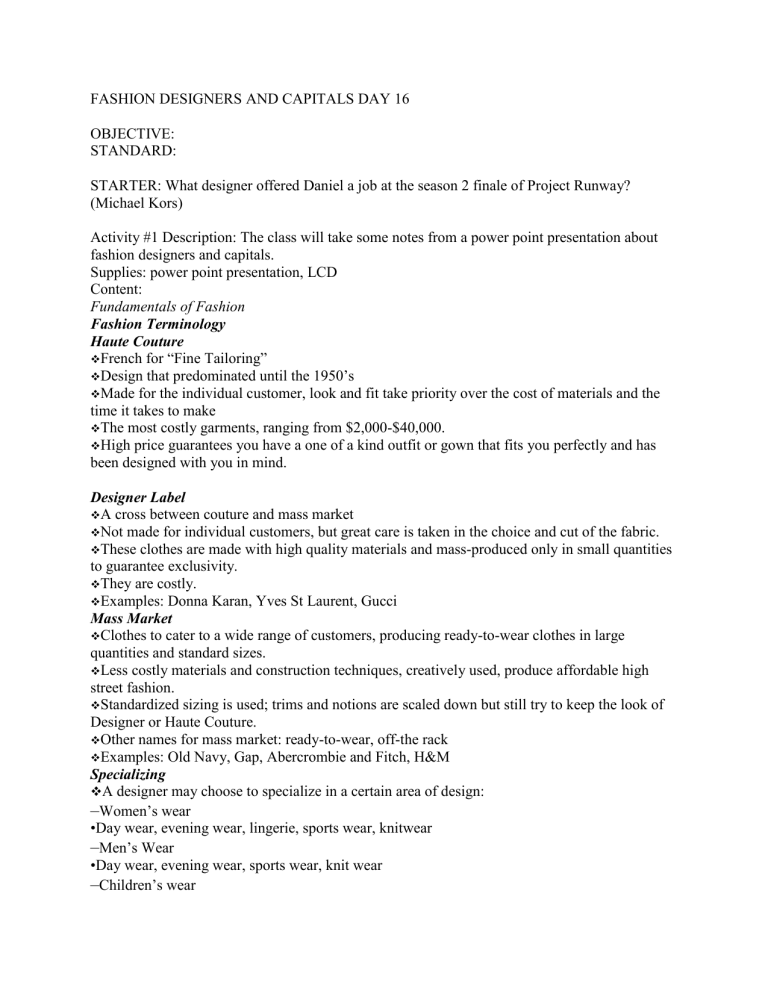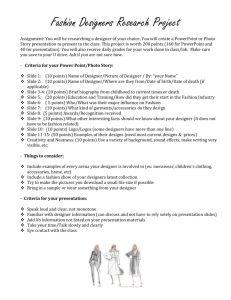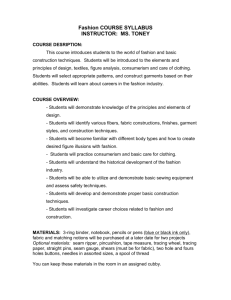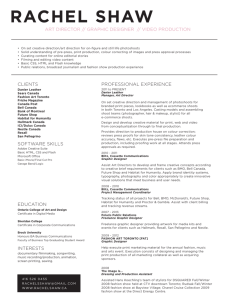FASHION DESIGNERS AND CAPITALS DAY 16

FASHION DESIGNERS AND CAPITALS DAY 16
OBJECTIVE:
STANDARD:
STARTER: What designer offered Daniel a job at the season 2 finale of Project Runway?
(Michael Kors)
Activity #1 Description: The class will take some notes from a power point presentation about fashion designers and capitals.
Supplies: power point presentation, LCD
Content:
Fundamentals of Fashion
Fashion Terminology
Haute Couture
French for “Fine Tailoring”
Design that predominated until the 1950’s
Made for the individual customer, look and fit take priority over the cost of materials and the time it takes to make
The most costly garments, ranging from $2,000-$40,000.
High price guarantees you have a one of a kind outfit or gown that fits you perfectly and has been designed with you in mind.
Designer Label
A cross between couture and mass market
Not made for individual customers, but great care is taken in the choice and cut of the fabric.
These clothes are made with high quality materials and mass-produced only in small quantities to guarantee exclusivity.
They are costly.
Examples: Donna Karan, Yves St Laurent, Gucci
Mass Market
Clothes to cater to a wide range of customers, producing ready-to-wear clothes in large quantities and standard sizes.
Less costly materials and construction techniques, creatively used, produce affordable high street fashion.
Standardized sizing is used; trims and notions are scaled down but still try to keep the look of
Designer or Haute Couture.
Other names for mass market: ready-to-wear, off-the rack
Examples: Old Navy, Gap, Abercrombie and Fitch, H&M
Specializing
A designer may choose to specialize in a certain area of design:
– Women’s wear
•Day wear, evening wear, lingerie, sports wear, knitwear
– Men’s Wear
•Day wear, evening wear, sports wear, knit wear
– Children’s wear
•Boy’s wear, girl’s wear, teenage clothes, knitwear
A fashion year
Two main seasons
–
Spring/Summer
–
Autumn/Winter
Both require a different fashion look and a new range of colors and fabric designs for the time of year.
–
Lightweight fabrics in summer
–
Heavier fabrics in winter
The plan...
Designers work a year in advance
–In the spring, the studio works for the spring/summer of the following year
–Once a collection is finished, on to the next!
Research
–Each collection is researched so that all the items in it complement each other, will be in style, and have the particular look for which the company is known for.
Predicting Trends
–A designer’s most difficult task is forecasting what will be in style for the coming years. To do this, they know the past trends and look at repeats. They also purchase HIGH priced trend magazines. Additionally they observe what succeeded with customers in the past.
The Collection
Theme
–A designer selects a theme that represents their collection. It can be a period in history, a foreign place, a range of colors, and a type of fabric…
Designing
–After the groundwork is completed for the nature of the collection, the designer must decide how many and what types of garments should be included in the collection.
–Usually, they have a three-month period to design, produce and publicize the collection in time for their fashion show.
–Press and buyers get their first look at the collection at the show
The Design
Steps
–Designers work differently to put the design ideas together: some sketch, drape fabric on a dress stand, or use patterns from previous seasons
–Create a paper pattern
–Make a muslin sample
–Try it on (a dress stand or live model) adjustments are made
–When fit is right, a professional pattern cutter makes an accurate pattern
–A sample item is made in the fashion fabric, then produced in various colors
–Fashion show: reveals the finished designs in their most attractive state
What are the careers involved in creating a collection?
Fashion Designer
Textile Designer
Fashion Illustrator
Pattern Cutter
Fashion Photographer
Fashion Journalist
Public relations consultant
Fashion Buyer
Stylist
Fashion Model
Where is the easiest place to find work in these careers?
Design Capitals
There are many cities around the world that host a strong fashion economy but five major cities are considered by most to be the centers of the fashion world.
Which five cities do you think host fashion for the world?
Milan, Italy
These fashions have a reputation for casual elegance and luxurious fabrics. Many Italian couturiers, such as Valentino, are based in Rome. However, Milan is seen as the fashion capital of Italy because many well-known designers are based there and it is the venue for the Italian designer collections, which take place at an exhibition center called the Diera di Milano or the
Milan Fair
Milan
Italian Designers
Giorgio Armani
Alma Couture
Filippo Alpi Femme
Maria Grazia Amoretti
Roberta Badio
Baila
Maurizio Baldassari
Renato Balestra
Federico Bano
Basile
Bensussan
Laura Biagiotti
Blumarine
Chiara Boni
Mariella Burano
Byblos
Cailand
Callaghan
Armando Calo
Capucine
Gianna Cassoli
Emilio Cavallini
Ernestina Cerini
Complice
Anna e Cristina Costi
Raffaella Curiel
Dadoscorza by Edward De Carlis
Roberta De Castello
Dolce e Gabbana
Paris, France
Chic and stylish
Home of famous couture houses such as Dior and Chanel
–The houses stage exclusive fashion shows in their own salons. Many other famous French designers show their work twice a year.
One of the best-known French designers and a pioneer of ready to wear is Yves Saint Laurent.
He consistently turned out stylish, quality garments over many years.
One of the innovators of French fashion is Jean Paul Gauliter. He designs unusual witty clothes, which stand apart from the main thrust of French style. He designed for Madonna.
Paris
French Designers
Jin Abe
Balenciaga
Dorothee Bis
Cerruti Femme
Chanel
Chloe
Enrico Coveri
Christian Dior
Louis Feraud
Jean-Paul Gaultier
Romeo Gigli
Givenchy
Kenzo
London, England
Known for unorthodox clothes, with a young market and popular appeal.
Vivienne Westwood is one of the pioneers of street style, the name of daring youthful looks which London is known for.John Galliano, Richmond Cornejo and a design group called English
Eccentrics also turn out fresh ideas consistently.
Other well known names include Zandra Rhodes, Katharine Hamnett (known for slogan tshirts) and Bruce Oldfield who designs glamorous evening wear.
SPRING 2006
GHOST
London
London Designers
Bodymap
Joe Casely-Hayford
Caroline Charles
Nick Coleman
Paul Costelloe
Ghost
Pam Hogg
Betty Jackson
Bruce Oldfield
Ednia Ronay
Vivienne Westwood
Workers for Freedom
New York, New York, U.S.A.
American fashion design is dominated by a clean-cut casual style reflecting the sporty, healthconscious life styles of many Americans. The fashion industry in New York is based around
Seventh Avenue.
A designer who helped to set the trend in America for sport influenced day wear throughout the
1940’s and 50’s was Clair McCardell. Many of her styles have been revived. More recent influences on the American Look have been Calvin Klein, with classic coats, separates and jeans.
Ralph Lauren designs casually elegant clothes in natural fabrics and Donna Karan works with practical, sophisticated women’s wear.
New York
New York Designers
Geoffrey Beene
Bill Blass
Oscar De La Renta
Tom Ford (Gucci)
Halston
Carolina Herrera
Norma Kamali
Donna Karan
Calvin Klein
Ralph Lauren
Mary McFadden
Mary Ann Restivo
Scassi
Pauline Trigere
Tokyo, Japan
The look is lose and apparently unstructured. This is often the result of complicated cutting techniques. Colors are often subtle, and somber. Fabrics are rich and textured.
Many of the famous names in Japanese fashion now work in Europe or the USA, but the Tokyo designer collections are still a major international fashion event. Famous names in Japanese fashion include Kenzo, known for layered looks and highly original knitwear.
Miyake, considered a master of draping and cutting, and Rei Kawakubo who developed a completely new way of cutting. His work has been compared with the bias innovation of
Vionnet in the 1930’s.
Tokyo
Tokyo Designers
Jin Abe
Barbara Bui
Hiroko Koshino
Junko Koshino
Issey Miyake
Hanae Mori
Yuki Torii International
Kansai Yamamoto
The “Main Event” Calendar
January
–Italian and French couture collections for spring/summer in Paris and Rome
February
–British, Italian, American and French designer collections shown in London, Bologne,
Germany, and Paris
–IMBEX (International Men’s and Boy’s wear exhibition in London, England)
–International men’s fashion week in Cologne, Germany
March
–British, Italian, American and French designer collections for autumn/winter shown in London,
Milan, New York and Paris.
–Munich (Germany) Fashion Fair
April
–Interstoff clothing, textiles trade fair held in Frankfurt, Germany
May
–International designer collections, in Tokyo
–London mid-season fashion exhibition for autumn
June
–Italian children’s wear collections held in Florence, Italy
–Portex: Portugese ready-to-wear fashion fari for Spring/Summer in Porto
July
–French and Italian couture collections for Autumn/Winter, Paris and Rome
–Uomo Italia Men’s wear shown in Florence
August
–Future Fashions Scandinavia Fair held in Copenhagen, Denmark
–International men’s fashion week and international jeans fair in Cologne, Germany
–Finnish fashion fair in Helsinki
September
–British, French and American ready-to-wear collections for Spring/Summer shown in London,
Paris, New York
October
–
British, French, American and Italian designer collections for Spring/Summer in London, Paris,
New York and Milan
–
Interstoff – international textiles and trade fair in Frankfurt, Germany
November
–
International designer collections, Tokyo
December
–
Portex Portuguese ready-to-wear fashion fair for Autumn/Winter, Porto
Terms that keep designers in business..
Fashion
Fad
Classic
Style
Design
Trends
Fashion Cycle
Fashion
The currently accepted prevailing style.
What are the current fashions now?
Fad
A fashion with a sudden burst of popularity
What fads do you notice this year at school?
Style
A characteristic or distinctive form of dress that exists independent of fashion
Each person develops their own over time.
What is yours?
Classic
A fashion that retains general acceptance over a very extended period of time
What are examples of classics?
Design
Refers to a specific version of a style
Trend
The movement of a fashion into and through the marketplace
How long a fashion remains popular
Fashion Cycle
The introduction, Rise, Culmination, Decline, and Obsolescence of a given style over a period of time.
–Introduction: the beginning of a new style, trend
–Rise: gain in popularity and familiarity
–Culmination: the highest point or peak of the trend
–Decline: the end of a style or trend
Recurring cycle in skirt lengths
Trend Cycle
Design Details
Sleeve/Skirt/Pant/Short Lengths & Widths
Collar Types
Pockets
Topstitching
Neckline
What are some specific design details that fall under these categories?
Hip huggers
¾ length sleeves
Peter Pan Collar
Round Neckline
Assignment
Find 4 pictures that represent the following vocabulary words ** You must know the designers name for each picture
–Classic
–Fad
–Fashion
–Style
Glue each picture to a white paper or complete portfolio pages for extra credit
Paragraphs
–Write why the picture represents the vocabulary word
–Search for the designer’s web site… is the picture representative of their normal work? Why,
Why not?
–INCLUDE THE WEBSITE IN YOUR REPORT
Time: about 60 min
Process Questions and Answers: As we go through the slides I will ask questions that go with the slides.
Activity #2 Description: I will introduce the student’s next assignment dealing with the research of fashion designers and capitals. The students will draw which designer they will research. I will then have the students draw a number 1-6 (there will be 6 of each number). I will then assign each group a fashion capital. They will quickly get into their groups and decide who is going to research what when we go to the computer lab.
Supplies: pieces of paper with numbers on them
Content:
Fashion Report Assignment
Written Report on one of the following:
·
·
·
Fashion Capital
Fashion Designer
Historical Era
·
·
·
Requirements
·
Title Page: Centered: Name, Subject Chosen, Fashion Strategies, Period
2 pages long, double-spaced, 12 pt. Times New Roman Font
Bibliography on separate page, at least 2 sources
Oral Report with Pictures or PowerPoint with pictures
Make sure you include the following material in your report, according to the chosen subject:
·
·
·
Fashion History
·
Trends
·
Designers
Events that impacted fashion and the time period
Silhouette - How is it formed? How did it begin?
Fun: what were they doing, what is interesting?
·
·
·
Fashion Capital
·
·
·
Top Designers from the area or who started there
When do they host their fashion shows?
What fashion houses are in the area?
Other things the city is known for
Why did it become a fashion capital?
Interesting places and activities withing the capital?
·
·
·
·
·
·
Fashion Designer
·
Where are they from?
What is their capital?
Background: How did they come to be a designer?
What made them famous?
What is the main style of their lines?
When was their debut?
Interesting facts about the designer.
Rough Draft Critique
A paper should include the following
Ideas
1. Covers main points
2. Is focused on content
3. Gives interesting facts
Organization
1. Format Includes: title, introduction, supporting sentences and conclusion (conclusion ties back to introduction
2. Leads reader through a logical order
3. Uses transitions between phrases and paragraphs
4. All ideas are tied to whole
Conventions
Errors do not interfere with meaning:
1. Spelling
2. Punctuation
3. Capitalization
4. Grammar and usage
5. Legibility
Read through the paper and record the following on a post-it
·
·
2 positive points any improvements, use numbering system and then be specific
Example: “Organization 1, intro not tied to conclusion”
Works Cited/Creating a Bibliography
Books
One Author:Last name, first name and initial or middle name. Title . Place: Publisher, date of publication.Example: Deedy, Carmen Agra. The Library Dragon . Atlanta: Peachtree Publishers, Ltd,
1994.Two Authors:Last name, First name and initial or middle name, and First name Last Name. Title .
Place: Publisher, date.Example: Ryan, Pam Munoz, and Jerry Pallotta. The Crayon Counting Book .
Watertown, MA: Charlesbridge Publishing, 1996.Three authors:Last name, first name, First name Last name, and First name Last name. Title . Place: Publisher, date.Example: Jones, V.S., M.E. Eakle, and
C.W. Foerster. A History of Newspapers . Cambridge, Eng.: Cambridge UP, 1987. More than three authors:Last name, first name, et al. Title . Place: Publisher, date.Shields, J., et al. The History of English
Alley . Hartford: Merganser Press, 1997.
Encyclopedia Articles
When you know the author (the article is signed):Last name, first name. "Article Title." Title of
Encyclopedia (edition), volume number, page numbers.Example: Feinberg, Joe. "Cats." The World
Book Encyclopedia (1999), 3, 101-123.When you don't know the author's name (the article is unsigned):"Article Title." Title of Encyclopedia , (edition), volume number, page numbers. "Money."
Compton's Precyclopedia (1977 ed.), X, 80-91.
Magazine and newspaper articles
Last name, first name. "Article title." Title of magazine (Issue date): pages. Example: King, Peter. "The
Clutch." Sports Illustrated (31 January 2000): 42-45.
WORLD WIDE WEB
Author or originator. Title of item. [Online] Date of document or download (day, month, year). URL <http://address/filename>.
Example: U.S. Census Bureau. "American FactFinder: Facts About My Community." [Online] 17
August 2001. < http://factfinder.census.gov/servlet/BasicFactsServlet >.
ONLINE IMAGES
Author or originator. Description or title of image. [Online image] Date of document or download (day, month, year). URL <http://address/filename>.
Example: USGS. "Map: Major Volcanoes in Ecuador." [Online image] 17 August 2001.
< http://vulcan.wr.usgs.gov/Volcanoes/Ecuador/Maps/map_ecuador_volcanoes.html
>.
For an easy citing of your works, you can visit: http://www.landmark-project.com/citation_machine/cm.php
also see attached sheet
Time: about 10 min
Process Questions and Answers: I will answer any questions that the students might have.
Summary: The students will become familiar with fashion designers and capitals.
FASHION DESIGNERS AND CAPITALS DAY 17 and 18
OBJECTIVE:
STANDARD:
STARTER: What are the two main seasons in Fashion? (Spring/Summer and
Autumn/Winter)
Why does a designer select a theme to represent their line? (A designer selects a theme that represents their collection. It can be a period in history, a foreign place, a range of colors, a type of fabric…)
Activity #1, 2, and 3 Description: After the students are finished with their starters we will go done to the library where the students will use the class time to research their designer and capitals on the computer or in books.
Supplies: N/A
Content: N/A
Time: the entire class time
Process Questions and Answers: I will walk around making sure the students are on task and answer any questions that they might have.
Summary: The students will work on their fashion designer and capital presentations.
FASHION DESIGNERS AND CAPITALS DAY 19
OBJECTIVE:
STANDARD:
STARTER: What fashion designer and capital are you researching?
Activity #1 Description: We will finish the power point presentation that we started on
Monday.
Supplies: power point, LCD
Content: See day 16
Time: about 30 min
Process Questions and Answers: I will ask questions having to do with the slides we are going through.
Activity #2 Description: I will allow the students to work on their presentations for the rest of the class time. I will remind them that their designer presentations will be on
Monday and the Capitals will be on Tuesday. I will also tell them that this will be the last day in class that they have to work on this.
Supplies: N/A
Content: N/A
Time: the rest of the class time
Process Questions and Answers: I will go around and answer any questions that the students might have.
Summary: The class will finish taking notes on the fashion designers and capitals.
FASHION DESIGNERS AND CAPITALS DAY 20
OBJECTIVE:
STANDARD:
STARTER: Name the five fashion capitals. (New York, Tokyo, Milan, Paris, London)
Activity #1 Description: As a class we will talk about how important labels are in
Fashion. We will talk about how fashion designers use their names for other items besides clothing. The students will discuss items that they can think of dealing with this topic. They will then walk around the room looking at ads I have placed up and try to name the designer of the item being sold in the ad. They will go back to their seats and we will discuss what they wrote down.
Supplies: magazine pictures
Content: see attached sheets
Time: about 20 min
Process Questions and Answers: When I say Vera Wang what do you think of? What are some items that you can think of that designers market under their names?
Activity #2 Description: After we have discussed labels the students will go through their magazines and find 20 different labels. They will then neatly glue them to a piece of paper and turn it in.
Supplies: glue, paper, magazines
Content: N/A
Time: about 15-20 min
Process Questions and Answers: I will walk around and answer any questions that the students might have.
Activity #3 Description: The students will then come up with a name and design that they will market their fashion line under.
Supplies: ruler, glue, colored pencils, etc.
Content: See attached sheet
Time: the rest of class
Process Questions and Answers: I will walk around and answer any questions that the students might have.
Summary: The students will become more aware of labels and what they stand for.
Optional Activity: N/A
FASHION DESIGNERS AND CAPITALS DAY 21
OBJECTIVE:
STANDARD:
STARTER: What is a fad? Name one. (A fashion with a sudden burst of popularity)
Activity #1 Description: The students will present the designer that they have been working on for the past week. The rest of the class will take very brief notes on their classmate’s presentations.
Supplies: N/A
Content: the student’s presentations
Time: about 45-50 min
Process Questions and Answers: I will ask the students questions as they present and they will answer the questions of their fellow students.
Activity #2 Description: The students will watch some more clips from Project Runway.
They will decide which design is their favorite and which designer is their favorite.
Summary: The students will present their projects.
Optional Activity: The students will discuss as a table how they would have redesigned the winning garment on Project runway.
FASHION DESIGNERS AND CAPITALS DAY 22
OBJECTIVE:
STANDARD:
STARTER: Who where your three favorite designers from yesterdays’ presentations?
Activity #1 Description: The groups will present their group presentations and hand in their paper. The rest of the students will write down 3 new things that they learned about that capital in their notes.
Supplies: N/A
Content: the student’s notes and their papers
Time: about 15-20 min
Process Questions and Answers: The students presenting will answer any questions that their fellow classmates or I might have.
Activity #2 Description: The students will design 3 garments based on 3 of the 5 fashion capitals we have been talking about and they have been presenting on. They may use their notes to remind them what the styles of each of the capitals were. They will color these pictures and turn them in at the beginning of class tomorrow.
Supplies: tracing forms, colored pencils, paper
Content: The students will use their notes and what they learned from the presentations today to help them complete this assignment.
Time: The rest of class (they should all be able to finish at least most of this assignment in class)
Process Questions and Answers: I will walk around and answer any questions that the students might have about the assignment.
Summary: The students will present their presentations to the class and they will learn more about the different fashion capitals around the world.
Optional Activity: The students will partiapate in a trivia game about famous Americans.
FASHION DESIGNERS AND CAPITALS DAY 23
LATE START DAY
OBJECTIVE:
STANDARD:
STARTER: List the 5 fashion capitals and a designer from each capital. (London, New
York, Tokyo, Milan, Paris)
Activity #1 Description: As a class we will talk about some of the different careers, you can have dealing with fashion but not as a fashion designer. The careers we will talk about are; theater costuming, movies/TV shows, hair stylist, make up artiest, museum curator, models, etc.
Supplies: overheads, overhead projector
Content:
Model
Theatre costuming
Movies/TV show costuming
Hair stylist
Make up artiest
Museum Curator
Time: about 30 min
Process Questions and Answers: As we go through each of these careers, I will ask the students how much they know about each career.
Activity #2 Description: As we talk about each of these careers, I will show video clips that will give the students an idea of what these careers entail.
Supplies: video clips, TV
Content- Video’s-Cats, Circus o’la, Lord of the Rings, Americas Next Top Model, Les
Mis
Time: about 5-10 min each clip
Process Questions and Answers: As we watch the clips, I will go through and point out different topics that we had talked about in class.
Summary: The students will become familiar with different careers that the fashion industry has to offer.
Optional Activity: The students will watch part of a video and take a few notes on what they notice that someone with a career in Fashion would have helped create.
FASHION DESIGNERS AND CAPITALS DAY 24
OBJECTIVE:
STANDARD:
STARTER: Name 5 of the careers that we talked about yesterday. (Model, Theatre costuming, Movies/TV show costuming, Hair stylist, Make up artiest, Museum Curator)
Activity #1 Description: I have asked one of the costume designers from the Utah Valley
Festival Opera Company to come and speak to the students about a career in costume design. The students will fill out a little questionnaire to help them pay attention to the guest speaker.
Supplies: questionnaire for each student
Content: see attached questionnaire
Time: about 60 min
Process Questions and Answers: The students will ask the guest speaker any questions that they might have about a career in costume designing.
Summary: The students will become more familiar with a career in costume design.
Optional Activity: The students will watch part of a video and take a few notes on what they notice that someone with a career in Fashion would have helped create.
FASHION DESIGNERS AND CAPITALS DAY 25
OBJECTVIE:
STANDARD:
STARTER: List 3 things that you learned from the speaker yesterday.
Activity #1 Description: The students will be assigned to create 2 duck tape projects. The first project must be an article of clothing (i.e. shirt, vest, shorts, skirt, etc). The second project can be an accessory (i.e. shoes, wallet, purse, belt, etc.) They will decide what colors they will use and how they will go about putting it together.
Supplies: paper, pencil, duck tape purse as an example
Content: duck tape book
Time: about 25-30 min
Process Questions and Answers: I will walk around and answer any questions that the students might have.
Activity #2 Description: After the students have finished designing, their duck tape projects they will then start to create them.
Supplies: duck tape, scissors, paper bags
Content: N/A
Time: the rest of the class period
Process Questions and Answers: I will walk around and answer any questions that the students might have.
Summary: The students will work on their duck tape projects.
Optional Activity: N/A








